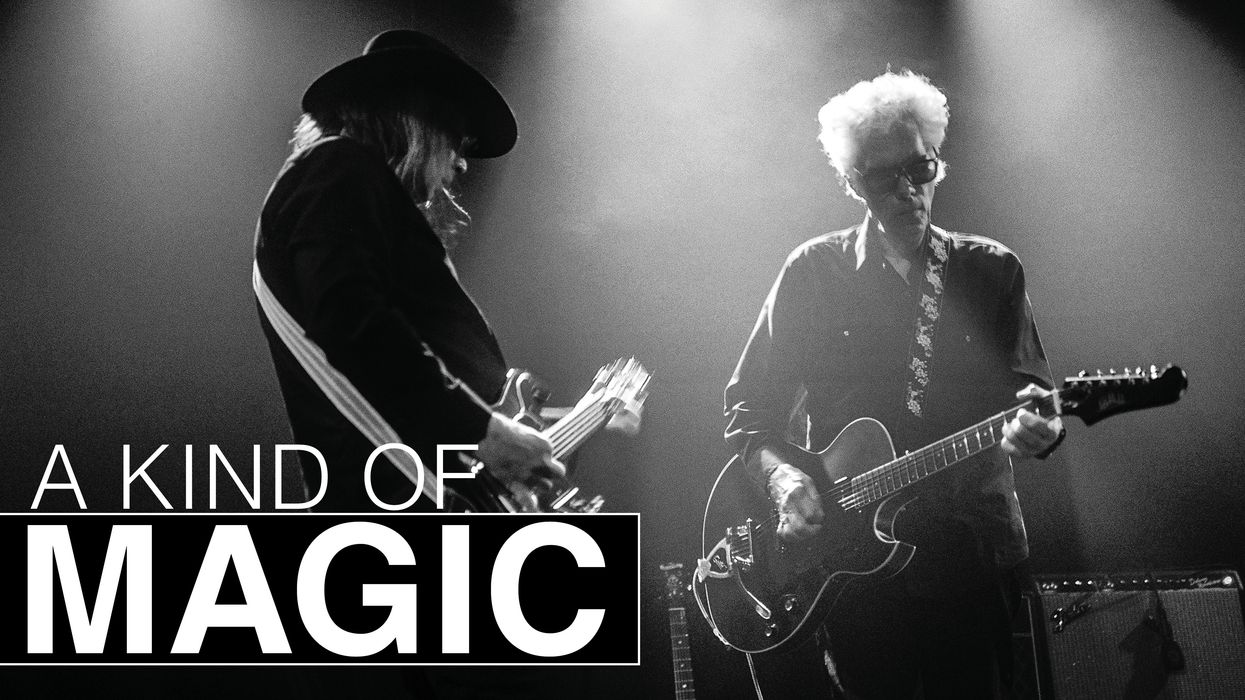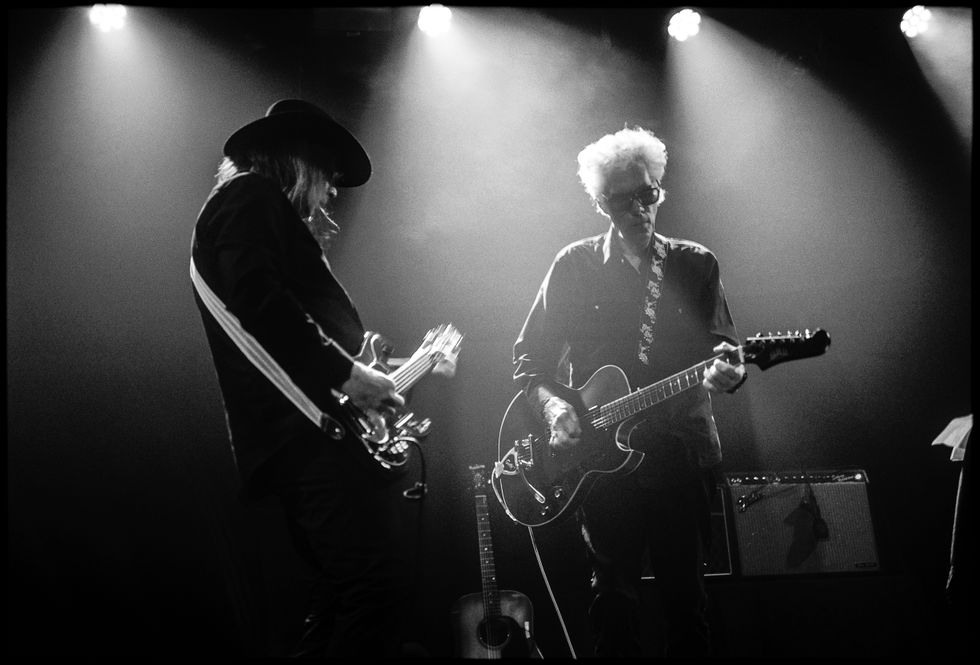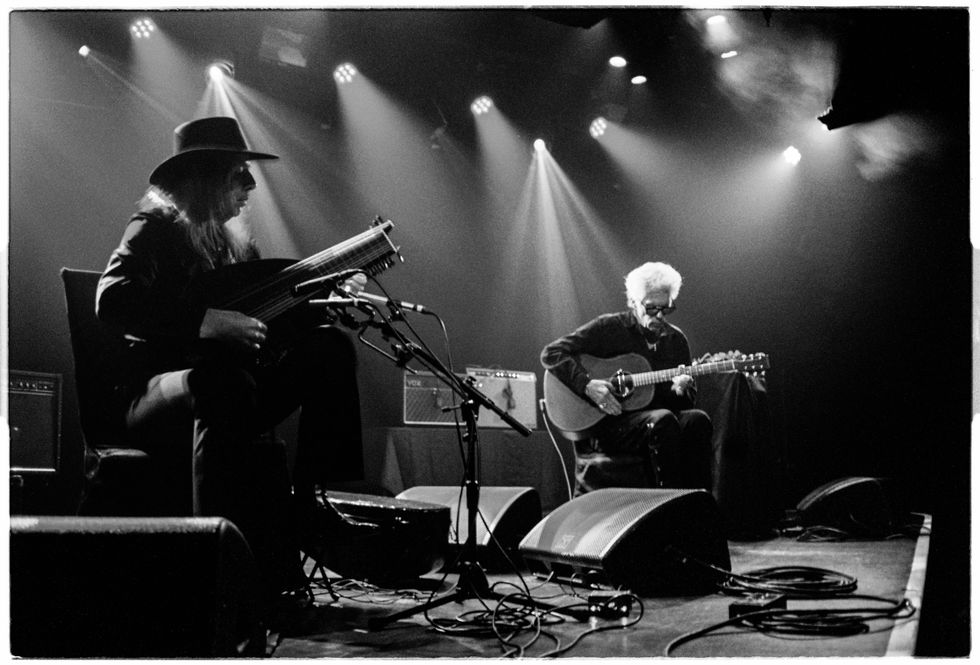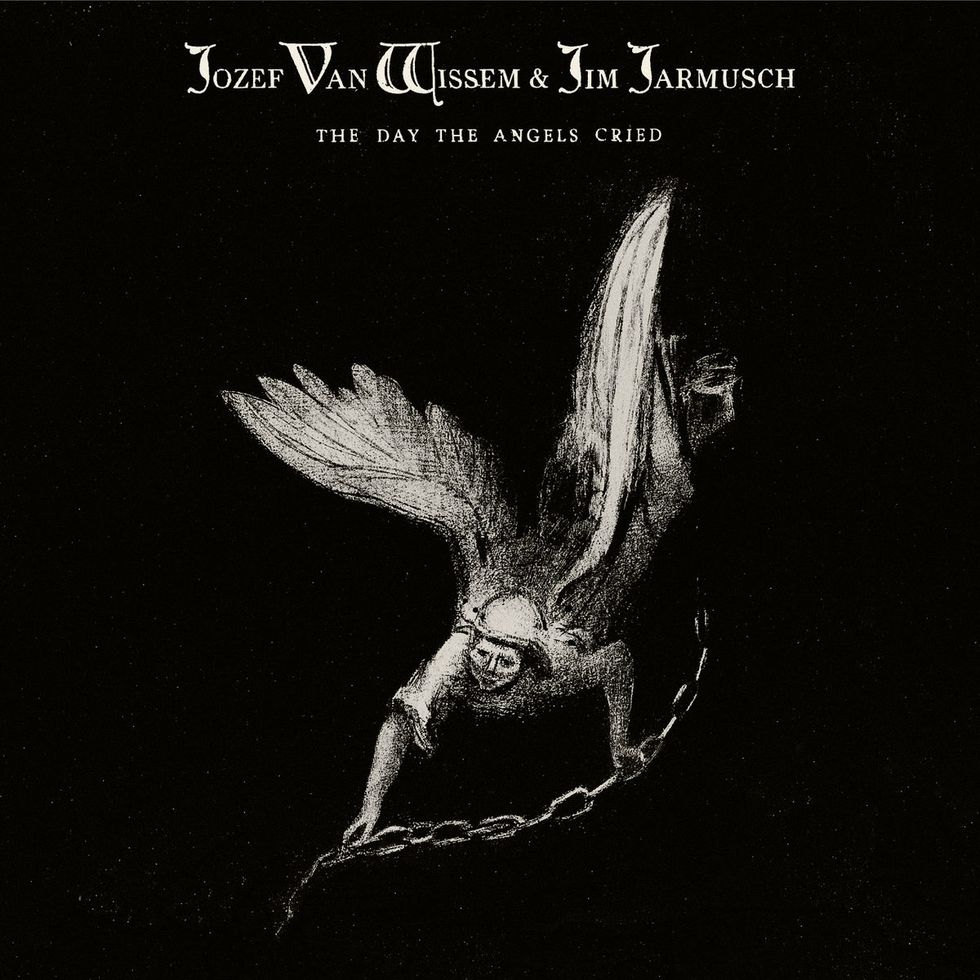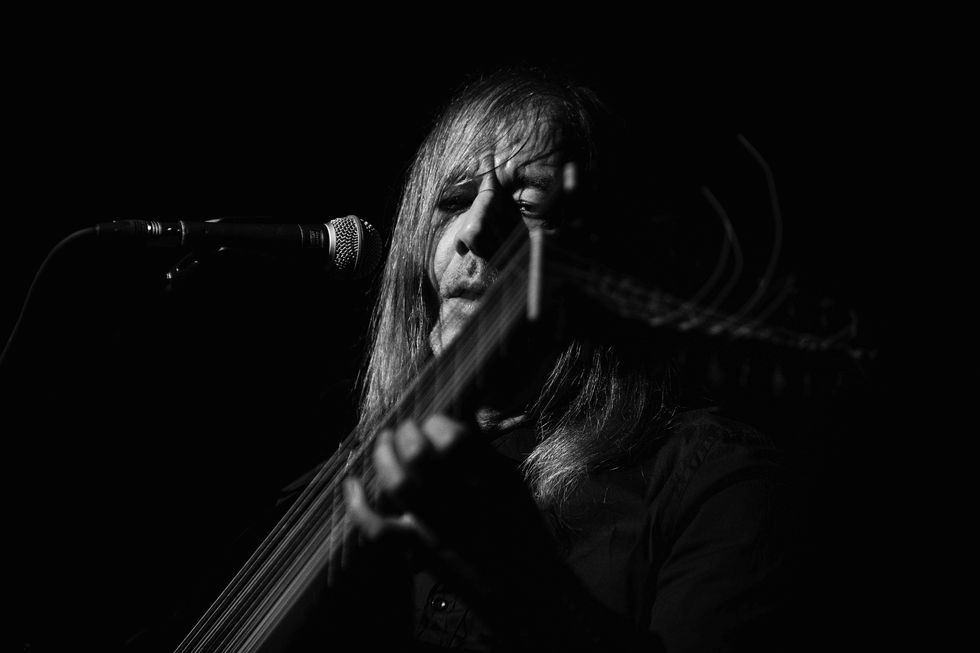Decemberists frontman Colin Meloy’s keening, reedy, distinctively traditional-Irish singing voice has always seemed to me like a tiny rebellion against the homogenizing effects of globalization on music. Over the past 75 years, the imitation of American pop and rock has spread like a pandemic—making the indelibility of Meloy’s Irish heritage on his sound a refreshing presence in modern U.S.-based indie folk. That, paired with the singer/songwriter/guitarist’s penchant for both novelistic and classic-prog-inspired storytelling, has kept the music of the Decemberists evergreen over the past two decades.
As It Ever Was, So It Will Be Again is the Portland, Oregon-based band’s ninth studio full-length, and their first in six years. “We’ve had a long arc of experimentation,” says supporting guitarist and multi-instrumentalist Chris Funk, reflecting on how the album partially honors various mosaic fragments of the band’s past works, while also expanding on them in a wise, informed, and beautiful, if not subtle, progression. “At the end of the day, there’s nothing wrong with going to a studio and making a record without a narrative. So, there’s no smoke and mirrors on this one.”
On As It Ever Was, So It Will Be Again, Meloy and Funk, joined by bassist Nate Query, keyboardist Jenny Conlee, and drummer John Moen, revisit the country twangs heard on The King Is Dead (2011), with “Long White Veil” and “All I Want Is You”; and even traipse back into the more worldly folk realm heard on Picaresque (2005) with the playful, chiming “Burial Ground” and folk-tango “Oh No!” Others, like the lo-fi electroacoustic, Grandaddy-esque “Born to the Morning,” build on elements from their previous release, 2018’s I’ll Be Your Girl—a record that’s pleasantly peppered with synths extracted straight from the Twin Peaks-, a-ha-, Tears for Fears-era of composition, and lyrics that could have been written by Moz himself. (“Oh, unabashedly,” says Meloy, moments after he recognizes the copy of the Smiths’ Hatful of Hollow seen mounted on the wall behind me on our Zoom call.)
“At the end of the day, there’s nothing wrong with going to a studio and making a record without a narrative. So, there’s no smoke and mirrors on this one.” —Chris Funk
The album concludes with “Joan in the Garden,” a 19-minute suite inspired by the story of Joan of Arc, which shamelessly hijacks the previous 49 minutes of rhapsodic folk songs with a summoning of Pink Floyd long-form-composition aesthetic, à la “Echoes,” “Sheep,” and “Dogs.” Sixteen minutes in, the spirit of Judas Priest rears its head with a muscular metal gallop that carries the track to a sudden and satisfying halt.
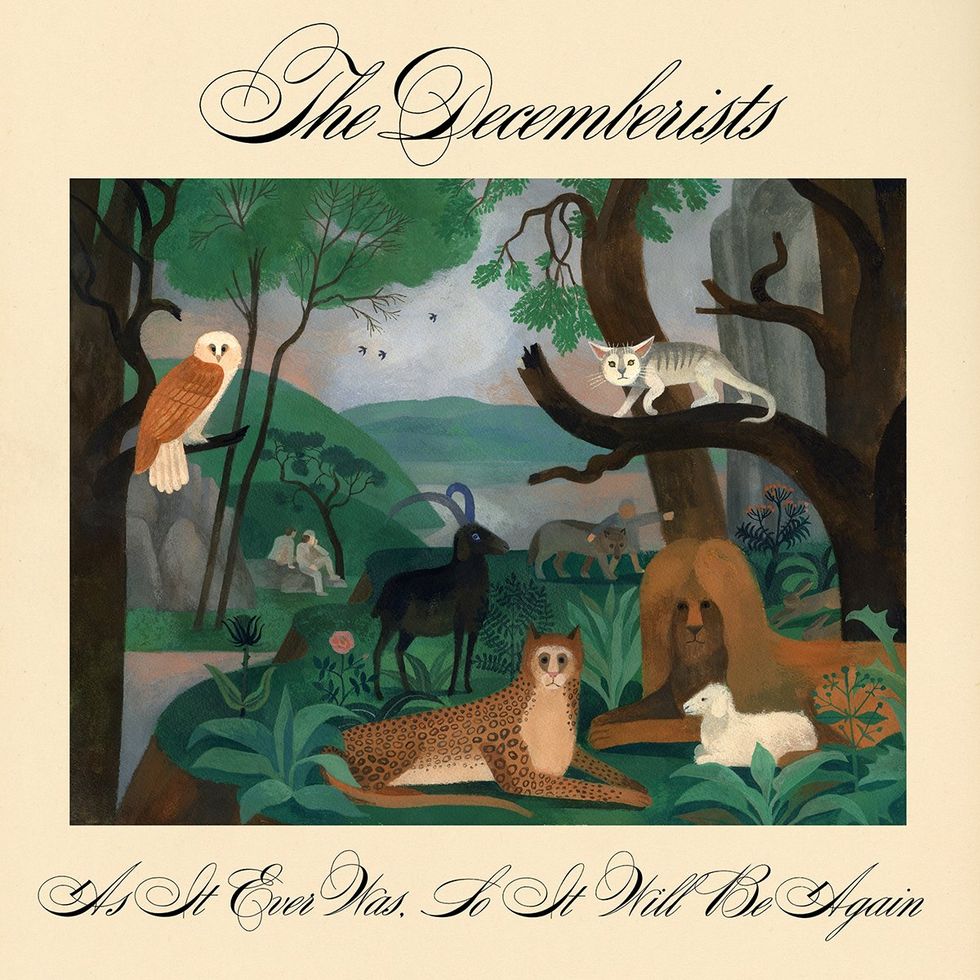
On As It Ever Was, So It Will Be Again, the Decemberists subtly call back to some past markers in their evolution, while still growing in their multifaceted traditional-, pop-, and prog-folk palette.
It’s been 18 years since the Decemberists’ The Crane Wife (2006), whose second track, “The Island,” rises with Keith Emerson-style synth towards the end of its 12-minute wayfaring, and 15 years since The Hazards of Love (2009), a crowning folk-rock opera in their overall discography. Yet, fans likely haven’t forgotten those earlier bold (and somewhat left-field) infusions of ’70s-prog dialect, and may welcome As It Ever Was, So It Will Be Again’s final, albeit extended, punctuation. What may come as a surprise, however, is that Meloy finds “a lot of prog to be sort of unlistenable.
“But,” he continues, “I have a weird kind of intellectual love for it. Being an ardent music fan, I can say I don’t really love Bob Dylan that much, for example, but I know everything about his career. I own so many records of his. There are certain people that, even if you don’t adore them or they don’t speak to your inner heart, you know how important they are, and you can see their contribution.”
Intersecting with that perspective is the fun fact that Meloy studied English, theater, and creative writing in college, and has a separate career as a children’s book author, with seven published works. “[Stories are] where my heart is, and that’s what drew me to people like the Pogues, Robyn Hitchcock, the Smiths. There’s a story being told, one way or another, in any of their songs,” he shares. “Prog also really lends itself to telling a longer story, a more sophisticated story. It kind of started with ‘California One’ on our first record, which is toying with these sort of longer-form suite songs, which can be owed to ‘Scenes from an Italian Restaurant’ by Billy Joel as much as anything Genesis did with Peter Gabriel. But I also think it was an opportunity to set ourselves apart from how we were being perceived [in the beginning].”
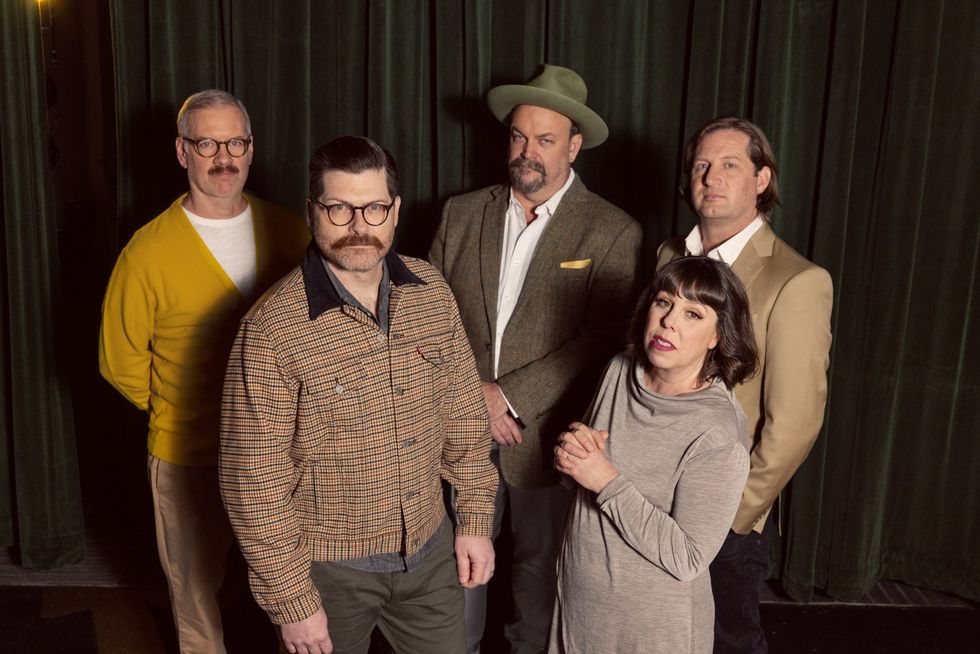
The Decemberists, from left to right: drummer John Moen, frontman Colin Meloy, guitarist/multi-instrumentalist Chris Funk, keyboardist Jenny Conlee, and bassist Nate Query.
Photo by Holly Andres
Speaking of setting themselves apart, Funk says that when the band was coming up in the early ’00s, they were one of the first in the indie-folk-rock scene to bring a broader array of folk instruments into their mostly “rock band” arrangements. Starting with their 2002 debut Castaways and Cutouts, the multi-instrumentalist has recorded a variety of stringed instruments on Decemberists albums aside from standard guitars, including dobro, pedal steel, lap steel, bouzouki, banjo, tenor guitar, baritone guitar, and mandolin. Funk has also contributed performances on other odds and ends, such as theremin, hammered dulcimer, Marxophone (a hammered, fretless zither), hurdy-gurdy, and synths.
“At the time when we signed to Kill Rock Stars [in 2003] and I moved to the Pacific Northwest,” says Funk, “there weren’t really rock bands with accordions [played in the Decemberists by Jenny Conlee] and pedal steels. And we really stuck out from our peer group. I think it was just wanting to expand our palette. Historically, there’s a lot of world-building in the Decemberists, so [I was thinking], what else could live inside that world? And then with the next record, how can we tear down that world and create something new?”
“Historically, there’s a lot of world-building in the Decemberists, so [I was thinking], what else could live inside that world?” —Chris Funk
That inspiration came in part from growing up listening to ’80s groups like R.E.M., whose guitarist Peter Buck first recorded mandolin on their sixth studio album, 1988’s Green. “I don’t even think I knew what a mandolin was when [I first heard it on R.E.M.’s songs],” Funk shares. “That was sort of our gateway into it.”
“There’s also bands like Belle and Sebastian,” Meloy adds. “It’s just like, everybody grab whatever instrument you have laying around and let’s give it a shot. There was a DIY [approach of], you don’t really have to be a virtuoso at this instrument to make songs with it. That was sort of the guiding principle, too.”
Of course, accordion, pedal steel, lap steel, banjo, and the like are hardly uncommon in country and folk settings, but were in the evolving 2000s indie-folk scene, which was competing (and still is) with a hip-hop and pop zeitgeist for the ears of a youthful audience. Other indie artists like Neutral Milk Hotel and Sufjan Stevens were also a bit ahead of the Decemberists, with Neutral Milk Hotel’s use of flugelhorn and musical saw on 1998’s In the Aeroplane Over the Sea, and Stevens’ generously broad mixture of folk instruments on his 2000 debut A Sun Came. However, along with those bands, the Decemberists rose to more popular visibility and influence circa 2005.
Colin Meloy's Gear

Frontman Colin Meloy identifies more as a songwriter than a guitarist, and focuses on storytelling through his songs.
Photo by Tim Bugbee/tinnitus photography
Guitars
- Gibson J-200 Montana Gold
- Gibson J-45 True Vintage
- Goya nylon-string
- Andrew Mowry bouzouki
- Two Guild F-512 12-strings (one is tuned down a half step)
- Reverend Buckshot
- Gretsch 6120 Chet Atkins
- Effects
- MXR Dyna Comp (modified with a 1980 CA3080E chip)
- ZVEX Box of Rock
- EHX Oceans 11
- Two Boss DD-3 Digital Delays
Amps
- Phoenix Audio DRS-Q4 MkII preamp (for acoustics)
- Carr Viceroy amp (for electrics)
- Orange OR50 head through a 2x12 cabinet (for electrics)
Strings & Picks
- D’Addario Light Acoustic (.012–.053)
- D’Addario Medium Wound 3rd Electric (.011–.049)
- Tortex .73 mm picks
- Golden Gate thumbpicks
❦
“Can you talk about your passion for guitar? That’s to the both of you,” I quiz Meloy and Funk halfway through the interview.
Meloy pauses, smiling. (At this point, he’s already confessed that he identifies more as a songwriter than a guitarist.) “Funk, would you like to talk about your passion for guitar?” he deflects, wryly.
“I think I was just saying I don’t have much left,” laughs Funk. “It’s just endless with electric guitar, with combinations of amps and pedals and the revival, or the beginnings of, boutique pedal building. I mean, it’s kind of insane. I’ve kind of put a moratorium on buying pedals, but it’s always fun just to see what people are building and that people are still pushing it. I’m not really attracted to people building 17-string guitars or anything like that, but I’m passionate about the possibilities of making the guitar sound less and less like a guitar.
“I religiously watch Rig Rundowns,” he continues. “I literally watch them every night. I’m just fascinated with how people are doing stage setups. I love it. I’m really fascinated with all the metal players or the heavier players; it seems like everybody’s using Fractal systems now, but even that’s interesting to me. I’ll never do it. But I think that’s cool.”
❦
Chris Funk's Gear

Multi-instrumentalist Chris Funk has contributed a wide variety of instruments to the Decemberists’ recordings over the years, and lately, has felt a bit more detached from the guitar. He still, however, obsessively watches Rig Rundowns.
Photo by Debi Del Grande
Guitars
- Weber Yellowstone Octave Mandolin
- Deering John Hartford Banjo
- Reverend Club King 290
- Gibson ES-390
- Gibson Chris Cornell Signature ES-335
- Eastwood Messenger
- Reverend Airwave 12-string
- Fylde Falstaff acoustic
- Epiphone Elitist ES-335
- Sho-Bud E9 pedal steel
Amp
- Supro 1695T Black Magick 1x12 combo (pedal steel)
- Two early Benson Monarch amps with Tall Bird reverbs
- Benson 1x12 cabs
Effects
For pedal steel:
- Boss FV-500 volume pedal
- Malekko Spring Chicken reverb
For electrics:
- Tuner
- Xotic AC Booster
- Keeley Dark Side
- Boss MT-2 Metal Zone
- Third Man Mantic Flex
- Boss SY-1 Guitar Synthesizer
- Strymon TimeLine
- Radial Twin-City ABY amp switcher
For acoustics:
- Fishman Aura Spectrum DI preamp
- Voodoo Lab Amp Selector
- Radial DIs
Modular Synth Rig:
- Busy Circuits Pamela’s Workout Master Clock
- Mutable Instruments Plaits
- Mutable Instruments Rings
- Knobula Poly Cinematic
- Strymon Magneto
- Instruo Arbhar
- Make Noise Rosie
Strings
- D’Addario Light Acoustic Guitar Strings (.012–.053)
- D’Addario Medium Wound 3rd Electric Guitar Strings (.011–.049)
Meloy and Funk were in their mid and late 20s, respectively, when they founded the Decemberists, and spent the following years of youthful adulthood developing a deeper friendship. When Meloy comments modestly on his guitar skills, Funk chimes in, “I think you’re undercutting your guitar playing. Colin’s a really great guitar player.”
“I learned a lot about guitar from Funk,” Meloy obliges. “I feel like when I started the Decemberists, I was afraid of electric guitar to a certain degree, and was much more comfortable with acoustic guitar. Funk has sort of pushed me in the direction of experimenting with guitar tones and pedals and setups and stuff like that. [I have gone] in that direction a little bit … not necessarily kicking and screaming, but just like, so intimidated by it. [He’s helped me to] open up to some ideas and approaches I don’t think I would’ve had before.”
That appreciation is mutual, as Funk shares his own perspective on what they’ve learned from one another over the years: “Colin’s always been pretty bold with some ideas that one might not do when they’ve entered a period of recording their second record on a major label—making Hazards of Love, which is a 45-minute folk-rock opera, if you will. So my takeaway is that the art comes first and it’s not always trying to find a single—it’s just being brave, to write from the heart.”
YouTube It
With Meloy on a Guild 12-string and Funk on a Reverend semi-hollowbody, the Decemberists rock their way through their 12-minute narrative folk-prog composition “The Island,” from 2006’s The Crane Wife.




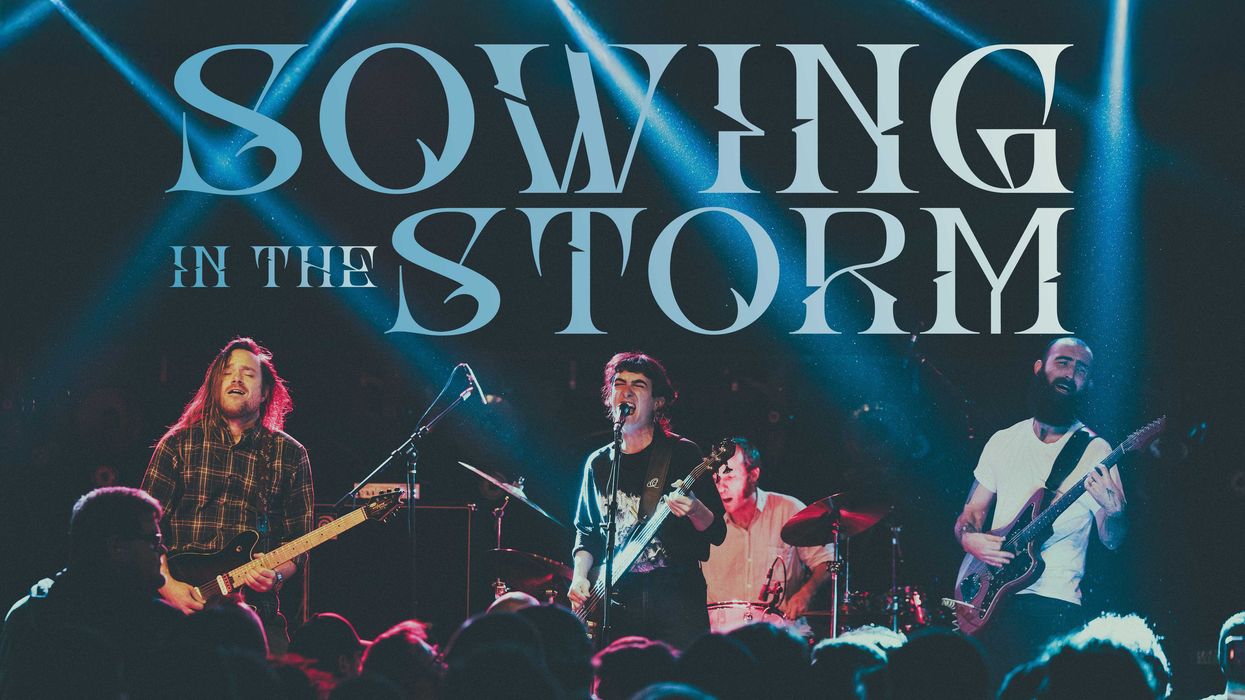

![Devon Eisenbarger [Katy Perry] Rig Rundown](https://www.premierguitar.com/media-library/youtube.jpg?id=61774583&width=1245&height=700&quality=70&coordinates=0%2C0%2C0%2C0)
























































